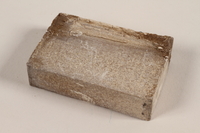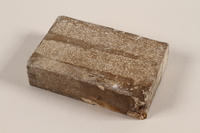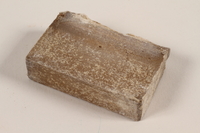Overview
- Brief Narrative
- Bar of soap issued for sale in the store of the grandfather of Frank Skopec by the German Authority for Civilian Supplies in 1945. He had a shop in the Sudetenland region of Czechoslovakia which was annexed by Germany in fall 1938. It was rumored that it was made from human fat. However, this was not the case. A soap bar from this collection. 1989.264.1, was sent for laboratory analysis. The lab tests indicated that the soap contained no fatty acids, human or otherwise. It is composed primarily of a substance similar to micah or pumice and also includes traces of barium sulfate. Lab scientists compared it to a "mechanic's soap" and said that it contained no form of human remains.
- Date
-
received:
approximately 1944-before 1945 May
- Geography
-
distribution:
Zabreh (Sumperk, Czech Republic)
- Credit Line
- United States Holocaust Memorial Museum Collection, Gift of Ana and Frank Skopec in memory of Karel Zlámal
- Contributor
-
Subject:
Frank Skopec Sr.
- Biography
-
Frank Skopec was born in 1923 to a Catholic family in the Sudentenland region of Czechoslovakia. His grandfather ran a general store in Zabreh. The Sudetenland bordered on Germany and a large proportion of the population was ethnic German. Hitler came to power in Germany in 1933 and one of his announced aims was to reclaiim regions such as this for the Third Reich. On September 29-30, 1938, France, Great Britian, and Italy met with Hitler in Munich. Czechoslovakia was not invited to the conference. The three countries agreed to Hitler's seizure of the region in exchange for a promise of peace. When the region was annexed, Frank and his family were arrested. They were later released, but had to report to the police twice a day for the next two years and were not permitted to leave the city without a special permit. Frank immigrated to the United States in 1953. He and his wife Ana settled in Rockville, Maryland, and raised two children. Frank passed away on December 5, 2005.
Physical Details
- Classification
-
Personal Equipment and Supplies
- Object Type
-
Soap (lcsh)
- Physical Description
- Unused, rectangular, smooth, dense, speckled light brown soap with sharp corners and flat sides. The top edge is rough and uneven with dark stains, especially at the corners. The back is smooth with a triangular chip and shallow striations at the top. Letters and numbers are impressed on the front.
- Dimensions
- overall: Height: 0.625 inches (1.588 cm) | Width: 2.375 inches (6.033 cm) | Depth: 1.500 inches (3.81 cm)
- Materials
- overall : soap
- Inscription
- front, center, impressed : 6 / RIF 0367 / RIF [RIF: Reichsstelle für Industrielle Fettversorgung /Reich Center for Industrial Fat Provisioning]
Rights & Restrictions
- Conditions on Access
- No restrictions on access
- Conditions on Use
- No restrictions on use
Keywords & Subjects
- Topical Term
- General stores--Czech Republic--History.
- Geographic Name
- Sudetenland (Czech Republic)--Social life and customs.
Administrative Notes
- Legal Status
- Permanent Collection
- Provenance
- The soap was donated to the United States Holocaust Memorial Museum in 1988 by Frank and Ana Skopec.
- Funding Note
- The cataloging of this artifact has been supported by a grant from the Conference on Jewish Material Claims Against Germany.
- Record last modified:
- 2022-07-28 18:21:01
- This page:
- https://collections.ushmm.org/search/catalog/irn368
Download & Licensing
In-Person Research
- By Appointment
- Request 21 Days in Advance of Visit
- Plan a Research Visit
- Request to See This Object
Contact Us
Also in Ana and Frank Skopec collection
The collection consists of four bars of RIF soap issued by the German Authority for Civilian Supplies to a shopkeeper, grandfather of Frank Skopec, in the Sudetenland region in German annexed Czechoslovakia.
Date: 1944-1945

Unused brown soap bar with scratches imprinted RIF 0367
Object
Bar of soap issued for sale to the grandfather of Frank Skopec by the German Authority for Civilian Supplies in 1945. He had a shop in the Sudetenland region of Czechoslovakia which was annexed by Germany in fall 1938. It was rumored that it was made from human fat. However, this was not the case. This bar was sent for laboratory analysis. The tests indicated that the soap contained no fatty acids, human or otherwise. It is composed primarily of a substance similar to micah or pumice and also includes traces of barium sulfate. Lab scientists compared it to a "mechanic's soap" and said that it contained no form of human remains.

Unused brown soap bar with broken corner imprinted RIF 0667
Object
Bar of soap issued for sale in the store of the grandfather of Frank Skopec by the German Authority for Civilian Supplies in 1945. He had a shop in the Sudetenland region of Czechoslovakia which was annexed by Germany in fall 1938. It was rumored that it was made from human fat. However, this was not the case. A soap bar from this collection. 1989.264.1, was sent for laboratory analysis. The lab tests indicated that the soap contained no fatty acids, human or otherwise. It is composed primarily of a substance similar to micah or pumice and also includes traces of barium sulfate. Lab scientists compared it to a "mechanic's soap" and said that it contained no form of human remains.

Unused brown soap bar imprinted RIF 0667
Object
Bar of soap issued for sale in the store of the grandfather of Frank Skopec by the German Authority for Civilian Supplies in 1945. He had a shop in the Sudetenland region of Czechoslovakia which was annexed by Germany in fall 1938. It was rumored that it was made from human fat. However, this was not the case. A soap bar from this collection. 1989.264.1, was sent for laboratory analysis. The lab tests indicated that the soap contained no fatty acids, human or otherwise. It is composed primarily of a substance similar to micah or pumice and also includes traces of barium sulfate. Lab scientists compared it to a "mechanic's soap" and said that it contained no form of human remains.



